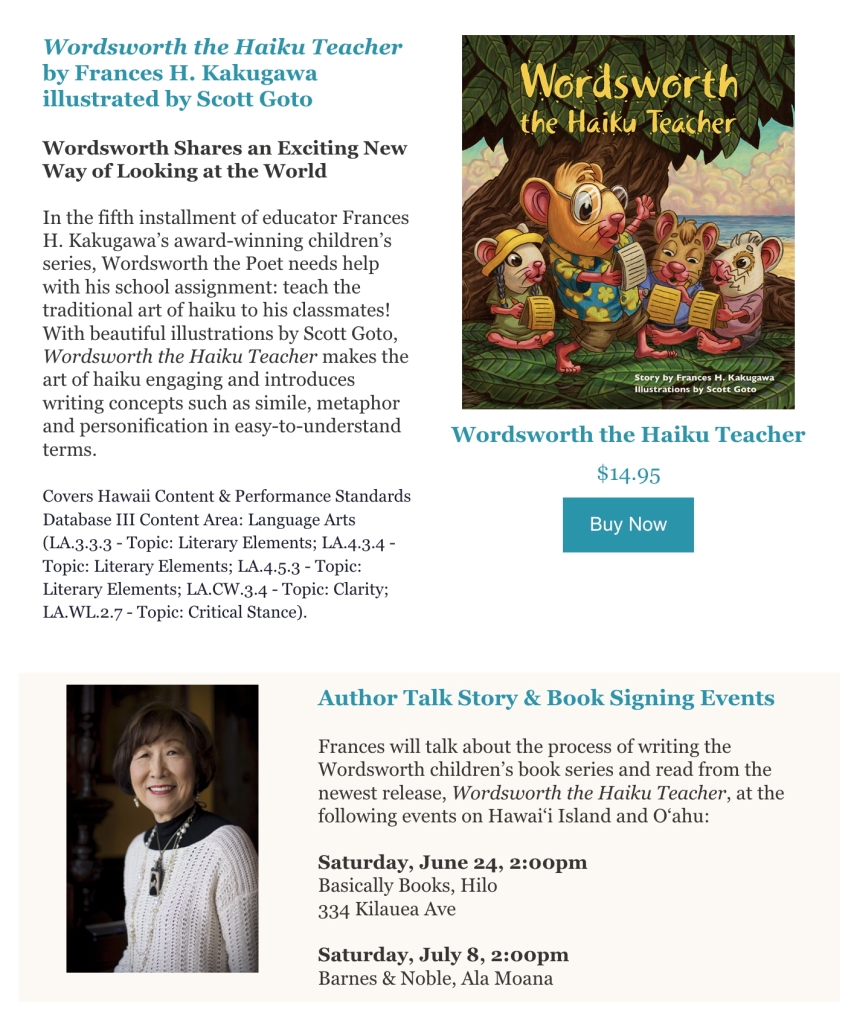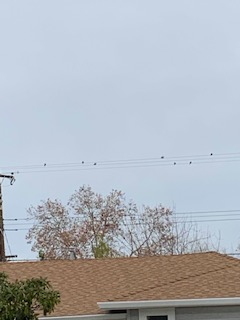
Archive for the ‘Haiku’ Category
See you in Hilo
Posted in Basically Books, Haiku, Wordsworth the Haiku Teacher, Writers, tagged Basically Books on June 19, 2023| Leave a Comment »
Wordsworth the Haiku Teacher
Posted in Haiku, On writing chldren's books, Sacramento Poetry Center, Wordsworth the Poet, Writers on June 1, 2023| Leave a Comment »
Wordsworth the Haiku Teacher
Posted in Haiku, Poetry, Poetry and Writing, Uncategorized, tagged California Writers' Club Sacramento, Haiku Writing, Sacramento Poetry Center, Wordsworth the Haiku Teacher on May 10, 2023| Leave a Comment »
My fifth Wordsworth book in my Wordsworth the Poet series is here. I’ll be in Hawaii for book signings, talks on Wordsworth and other workshops. Stay tuned for dates. Hilo friends, I’ll be at Basically Books on June 24th at 2:00 p.m. I’ll be discussing how I wrote all five Wordsworth books and Wordsworth promised to make an appearance. Please drop by to say hello.
My Oahu events are still in pencil. I will post them when they’re in ink. I’ll be speaking on caregiving and will do a poetry writing workshop along with book signings.


A living Haiku
Posted in Haiku on December 9, 2022| 2 Comments »
A Living Haiku Greeted Me This Morn
Posted in Haiku, morning glory, Nature, tagged A Living Haiku on September 13, 2021| 2 Comments »
A lesson in Haiku writing
Posted in Agelessness, Haiku, Uncategorized, tagged Haiku Writing, Poetry on February 16, 2020| Leave a Comment »
I will be presenting a session called Capturing a Haiku Moment tomorrow for the International Ikebana Society. I’m reminded of a similar session I did some years ago. Here’s hoping for a successful afternoon even if the children won’t be there.
Scheduled to “teach” a Haiku Poetry Workshop at the Asian Pacific Heritage Celebration at the Foster City Library, I prepped the room by taping haiku poems by Basho, Shiki and Shosan on the walls
Imagine my jolt when I walked into the room and saw children and adults. I was expecting an adult only audience. I took a deep breath and said, “I’m going to direct the next hour to the children, so adults, I hope you’ll be able to rise to their level.” Laughter.
It was the children who responded, disregarding the age differences in the room. They turned into artists and described each of the images created by the poems on the wall. “Isn’t it amazing?” I asked, “that you are able to get such clear images in your head through three lines of words, 17 syllables. ”
We wrote a group haiku so they would experience the mental and creative process of writing a haiku.
The image was the most important, not the 17 syllables. Let’s get the image down first.
The lst draft had the following syllables 4-6-4. We returned to the draft and edited until we had the 5-7-5. We had agreed to go for the 5-7-5 form.
The children gave the lst two lines and one adult male added the 3rd.
His line read: Sound of a truck.
A youngster added, “How about changing truck to “engine.” And so the discussion began between children and adults.
I quoted Basho’s “Learn of the pine from the pine.” Everyone wrote one or more haiku.
They understood Basho…capturing the ah-ness of the moment without metaphorical language.
They understood the preservation of a haiku moment by using words without personification.
They understood how we learn of the pine from the pine.
When I left, a 9 year old boy was sitting alone, working on his 3rd haiku. An adult, whose eyes had shone like the children, plan to form a haiku group.
The workshop supported my stance on writing and reading. Why do we attach age or grade level to reading? One never hears of a 20 year old reader. Yet, we say, he is reading at the 4th grade level. Why do we attach age to literature? Why do we call them children’s books?
Do we speak of a book for 30 year olds?
I’m often asked about the age level of my Wordsworth books. I merely say, “I’ve signed these books for unborn children to adults.”
In that room, there was no age.
( The latest study speak of our congressmen and women conversing at the 10th grade level. Tenth graders, ask for an apology for this insult.)
Haiku inspired by Morikami Museum
Posted in Haiku, Morikami Museum FL, Nature, Nature vs. Man, Uncategorized, tagged Morikami Museum, Nature Vs Human on August 20, 2019| 4 Comments »

The sound of my shoes
Breaks the silence of the fog.
Forgive my entrance.
The trees move slowly
Against the cold morning skies…
Or is it the fog?
The sound of geta…
A Samurai’s swinging sword..
A silence, broken.
Haiku inspired by photo: frances kakugawa
3 of my favorite quotes for Poetry Month
Posted in Haiku, Nature, Poetry, poetry month, Sacramento Poetry Center, Uncategorized, tagged Haiku, Poetry Month, quotes on poetry, Sacramento Poetry Month on April 21, 2018| Leave a Comment »
“There is no poetry for the practical man. There is poetry only for the mankind of the man who spends a certain amount of his life turning the mechanical wheel. But let him spend too much of his life at the mechanics of practicality and either he must become something less than a man, or his very mechanical efficiency will become impaired by the frustrations stored up in his irrational human personality.
An ulcer, gentlemen, is an unkissed imagination taking its revenge for having been jilted. It is an unwritten poem, a neglected music, an unpainted water color, an undanced dance. It is a declaration from the mankind of the man that a clear spring of joy has not been tapped, and that it must break through, muddily, on its own.”
– John Ciardi
“Poems are not written to sing of the moon and flowers; they must speak of our hearts in response to the moon and flowers. We must never forget that in our hearts are the seeds of our poems. If we merely speak of the moon and flowers, poems become simply poetical forms, whatever the human heart may be. If these things become a part of ourselves, then we may admire them in verse.”
– Okuman Kotomichi
19th century
“A haiku . . . is a hand beckoning, a door half-opened, a mirror wiped clean. It is a way of returning to nature, to our moon nature, our cherry blossom nature, our falling leaf nature, in short, to our Buddha nature. It is a way in which the cold winter rain, the swallows of evening, even the very day in its hotness, and the length of the night become truly alive, share in our humanity, speak their own silent and expressive language.”
— R. H. Blyth, Haiku, Volume 1, page 243
Hawaii awaits with snow
Posted in Haiku, Hawaii, Nature, Uncategorized, tagged Haiku Writing, Mauna Kea on February 20, 2018| Leave a Comment »
This was taken from my niece’s backyard where I’ll be staying in Hilo.
Ah – Mauna Kea.
Beautiful Mauna Kea
Awaits my return.

A Near Perfect Haiku Morning
Posted in Haiku, Hawaii, Nature, Sacramento Poetry Center, Uncategorized, tagged Haiku, Hawaii, Poetry, Sacramento Poetry Center on August 5, 2017| 4 Comments »

Hawaiian style morn
Seven blooms on the 5th day.
If only twas May.
8-5-17
Sacramento, CA









